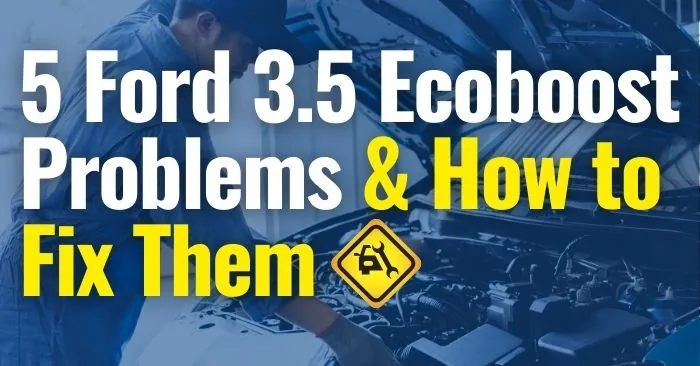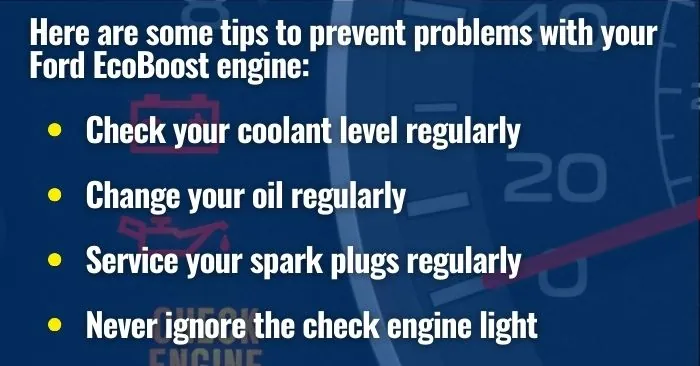
Written By: Jessica Anvar Stotz
Legally Reviewed By: Jessica Anvar Stotz

Short answer: The most common problems with the Ford 3.5 Ecoboost engine include carbon build-up, timing chain stretching, cam phaser problems, intercooler condensation, and ignition system failures. These problems often stem from the engine’s design and the significant stress placed on its components.
For instance, the direct fuel injection system can lead to carbon deposits, while the engine’s design contributes to wear and tear on the timing chain and cam phasers.
Read on to learn more about the common problems Ford Ecoboost drivers experience and how to fix them.
Problem #1 Carbon Build-Up
This issue primarily affects the first-generation engines (2010-2014) due to direct fuel injection, which leads to carbon deposits on the intake valves.
- What It Is: Carbon build-up refers to the accumulation of carbon deposits on key engine components such as intake valves, injector nozzles, cylinder walls, and piston heads. This issue is particularly common in engines with direct fuel injection, like the first-generation Ford 3.5L EcoBoost.
- Potential Causes: One primary cause of carbon build-up is the direct fuel injection system. Unlike port injection, where fuel is sprayed onto the intake valves, direct injection delivers fuel straight into the combustion chamber, bypassing the valves. As a result, the intake valves don’t benefit from the cleaning action of fuel, leading to carbon deposits.
- Another contributing factor is oil blow-by, which occurs when the Positive Crankcase Ventilation (PCV) system allows oil vapors to enter the intake system. These vapors adhere to the intake valves, eventually forming carbon deposits. Incomplete combustion of fuel can also leave behind carbon residues, which accumulate over time.
- Symptoms: Carbon build-up can cause a range of engine performance issues. You may notice a reduction in engine power and a decrease in fuel efficiency due to restricted airflow. The engine may also idle roughly or inconsistently, and misfires can occur, especially during acceleration. In some cases, the check engine light may illuminate because of sensor readings affected by carbon build-up.
- Potential Fixes: One effective method for removing carbon deposits is walnut blasting, a cleaning process that uses crushed walnut shells to blast away the build-up from the intake valves. Another preventative measure is the installation of an oil catch can, which captures oil vapors before they can reach the intake system, thereby reducing the likelihood of carbon deposits forming. Using high-quality fuel and adhering to a regular maintenance schedule can also help minimize the engine’s carbon accumulation.
Problem #2 Timing Chain Stretching
Over time, the timing chain can stretch, causing a rattling noise and potentially leading to engine misfires.
- What It Is: Timing chain stretching occurs when the timing chain elongates beyond its intended length, disrupting the engine’s timing and potentially leading to various performance issues.
- Potential Causes: One of the primary causes of timing chain stretching is normal wear and tear. Over time, the timing chain and its associated components, such as tensioners and guides, can wear out, resulting in the chain stretching. This is especially true for the first-generation 3.5L EcoBoost engines, which use a single-chain system that endures significant stress, leading to accelerated wear. Additionally, poor oil quality or infrequent oil changes can exacerbate wear on the timing chain, contributing to this problem.
- Symptoms: Several symptoms can indicate timing chain stretching, such as noticeable rattling or ticking noise coming from the engine, particularly during startup. This issue can also trigger the check engine light, as the engine’s timing becomes compromised. Other symptoms include engine misfires or rough running, especially at higher RPMs, and a noticeable loss of power and overall engine performance.
- Potential Fixes: When timing chain stretching occurs, the most effective solution is typically to replace the timing chain, along with any worn tensioners, guides, and other related components. Ensuring regular oil changes with high-quality oil can also help prevent excessive wear on the timing chain, extending its lifespan and maintaining engine performance.
Problem #3 Cam Phaser Issues
The cam phasers can fail, leading to a rattling noise during startup until oil pressure builds up.
- What It Is: Cam phasers are crucial components in the engine’s variable valve timing (VVT) system, responsible for adjusting the position of the camshaft to optimize engine performance and efficiency. When cam phasers malfunction, they can cause improper valve timing, which negatively impacts the engine’s operation.
- Potential Causes: Cam phasers can fail for several reasons. Over time, normal wear and tear can degrade these components, particularly in high-mileage engines. Poor oil quality or infrequent oil changes can also lead to sludge buildup, which interferes with the cam phasers’ ability to function correctly. Some early models of the 3.5L EcoBoost engine had design flaws in the cam phasers, making them more susceptible to failure.
- Symptoms: Several symptoms can indicate problems with cam phasers. A common sign is a rattling or ticking noise from the engine, especially during cold starts. This issue can also trigger the check engine light due to timing-related problems. You may also notice reduced engine performance, lower fuel efficiency, and rough or inconsistent idling.
- Potential Fixes: The most effective solution for cam phaser issues is to replace the faulty cam phasers. This is a complex repair that typically requires removing the valve covers and front engine cover. To prevent cam phaser problems, regular oil changes with high-quality oil are essential. Using updated or improved cam phasers can offer a more durable solution, addressing the design flaws present in earlier models.
Problem #4 Intercooler Condensation
Moisture can accumulate in the intercooler, leading to misfires and reduced engine performance.
- What It Is: Intercooler condensation occurs when moisture accumulates within the intercooler, which can then be drawn into the engine. This issue is particularly common in turbocharged engines like the Ford 3.5L EcoBoost, where the intercooler is responsible for cooling the compressed air before it enters the engine.
- Potential Causes: Several factors can lead to intercooler condensation. Operating the vehicle in high humidity environments can increase the amount of moisture that collects within the intercooler. Early models of the 3.5L EcoBoost engine had design flaws in the intercooler that made it prone to trapping moisture. Additionally, extended periods of idling can cause condensation to build up, exacerbating the problem.
- Symptoms: Intercooler condensation can cause various engine performance issues. One of the most common symptoms is engine misfires, particularly during acceleration, as moisture enters the combustion chamber. The engine may also run roughly or stumble, especially in humid conditions. In some cases, the check engine light may illuminate due to misfire codes or other related issues.
- Potential Fixes: To address intercooler condensation, Ford has redesigned the intercooler in later models to reduce moisture buildup. Another potential fix is to adjust the air deflector, repositioning it from the top to the bottom of the intercooler to help vaporize trapped condensation. Some owners have also resorted to drilling a small drain hole in the intercooler to allow condensation to escape, though this is generally considered a temporary and less ideal solution.
Problem #5 Ignition System Problems
Faulty spark plugs and ignition coils can cause misfires and rough idling.
- What It Is: Ignition system problems in the Ford 3.5L EcoBoost engine often involve issues with the spark plugs and ignition coils. These components are essential for igniting the air-fuel mixture within the engine’s cylinders, and any malfunction can lead to significant performance issues.
- Potential Causes: The high cylinder pressure inherent to the turbocharged EcoBoost engine puts extra stress on the spark plugs and ignition coils, which can lead to premature wear. Over time, these components naturally wear out, particularly under the high-performance demands of the EcoBoost engine. Additionally, poor maintenance, such as infrequent replacement of spark plugs and ignition coils, can exacerbate their degradation and lead to failure.
- Symptoms: Several symptoms can indicate problems with the ignition system. Engine misfires are a common issue, often becoming noticeable during acceleration or when the engine is under load. Rough idling is another symptom, where the engine may idle inconsistently. The check engine light may illuminate due to misfire codes or other ignition-related issues, and you may also notice a reduction in fuel efficiency due to incomplete combustion.
- Potential Fixes: To address ignition system problems, regular replacement of spark plugs according to the manufacturer’s recommended intervals is crucial. If ignition coils are found to be faulty, replacing them can restore proper engine function. Additionally, adhering to regular maintenance schedules and using high-quality parts can help prolong the life of the ignition system, ensuring optimal engine performance.

Is There a Recall for Ford’s 3.5 Ecoboost Engine?
Ford previously issued a Technical Service Bulletin (TSB) for certain 2017-2020 F-150, Expedition, and Lincoln Navigator models equipped with the 3.5L EcoBoost engine.
The bulletin addressed a problem where the engine produced a ticking or rattling noise during cold starts.
Although not as immediately dangerous as the brake fluid leak, this issue could indicate underlying engine problems that might worsen over time.
The 3.5L EcoBoost engine also caught the attention of the National Highway Traffic Safety Administration (NHTSA), which opened an investigation into engine failures, including those involving the 3.5L variant.
Reports of power loss and engine failure led to this investigation, raising further concerns among owners of vehicles with this engine.
If you own a vehicle with this engine, it might be a good idea to check with your local Ford dealer or the NHTSA website for any specific recalls or service bulletins that apply to your vehicle.
Who Pays for the Problems I’m Having?
Determining who pays for the repairs on your Ford 3.5L EcoBoost engine depends on several key factors:
- Warranty Coverage: If your vehicle is still under the manufacturer’s warranty, Ford typically covers the cost of repairs for issues considered defects in materials or workmanship. This includes coverage under the powertrain warranty, which often protects the engine and related components.
- Extended Warranty: If you purchased an extended warranty, it may provide coverage for repairs beyond the standard warranty period. The specifics of what’s covered will depend on the terms outlined in your extended warranty agreement.
- Recalls and Service Bulletins: If the issue is related to a recall or a technical service bulletin (TSB) issued by Ford, the manufacturer usually covers the repair costs, regardless of whether your vehicle is still under warranty.
- Out-of-Pocket Costs: If your vehicle is no longer under warranty and the problem isn’t covered by a recall or TSB, you may need to pay for repairs out-of-pocket. However, some dealerships may offer goodwill repairs or partial coverage, particularly if the issue is a common or well-documented problem.
It’s a good idea to check with your local Ford dealer to understand what coverage applies to your specific situation. They can provide detailed information on warranties, recalls, and any potential goodwill repairs.
How Hiring a Lemon Law Attorney Can Help
If you’re experiencing problems with your Ford 3.5L EcoBoost engine, enlisting the help of an experienced lemon law attorney can be a crucial step in addressing your concerns.
A knowledgeable attorney can offer valuable advice on your consumer rights and evaluate whether you have a valid claim under lemon law statutes.
They will guide you through the process, helping you understand your options and the steps needed to resolve the issue.
Attorneys specializing in lemon law are adept at negotiating with manufacturers and dealerships on your behalf.
They can advocate for necessary repairs, a replacement vehicle, or financial compensation. Should your case require legal action, your attorney will represent you in court, handling all aspects of the litigation process to ensure your interests are protected.
The Lemon Law Experts provide top-notch legal support for individuals facing challenges with defective Ford vehicles.
Since 2009, our attorneys have successfully secured substantial compensation for clients through refunds and settlements with major auto manufacturers, including the brands under Ford Motor Company.
If you have questions about your Ford 3.5L EcoBoost engine or need assistance with a lemon law claim, the Lemon Law Experts are here to help.
We offer a free, no-obligation consultation to assess your situation and provide the support you need. Contact us to explore your options and take the first step towards resolving your vehicle issues today.
Citations
CBS News. “Ford EcoBoost Engine Issues: Bronco, Edge, F-150, Explorer, Lincoln Nautilus, Aviator Engine Failure.” CBS News, https://www.cbsnews.com/news/ford-ecoboost-engine-bronco-edge-f150-explorer-lincoln-nautilus-aviator-suv-engine-failure/.
National Highway Traffic Safety Administration (NHTSA). “Technical Service Bulletin (TSB) – MC-10199482-0001.” NHTSA, https://static.nhtsa.gov/odi/tsbs/2021/MC-10199482-0001.pdf.
Cars.com. “2014-2017 Ford F-150 Brake Fluid Leak Recall Alert.” Cars.com, https://www.cars.com/articles/2014-2017-ford-f-150-brake-fluid-leak-recall-alert-454048/.




